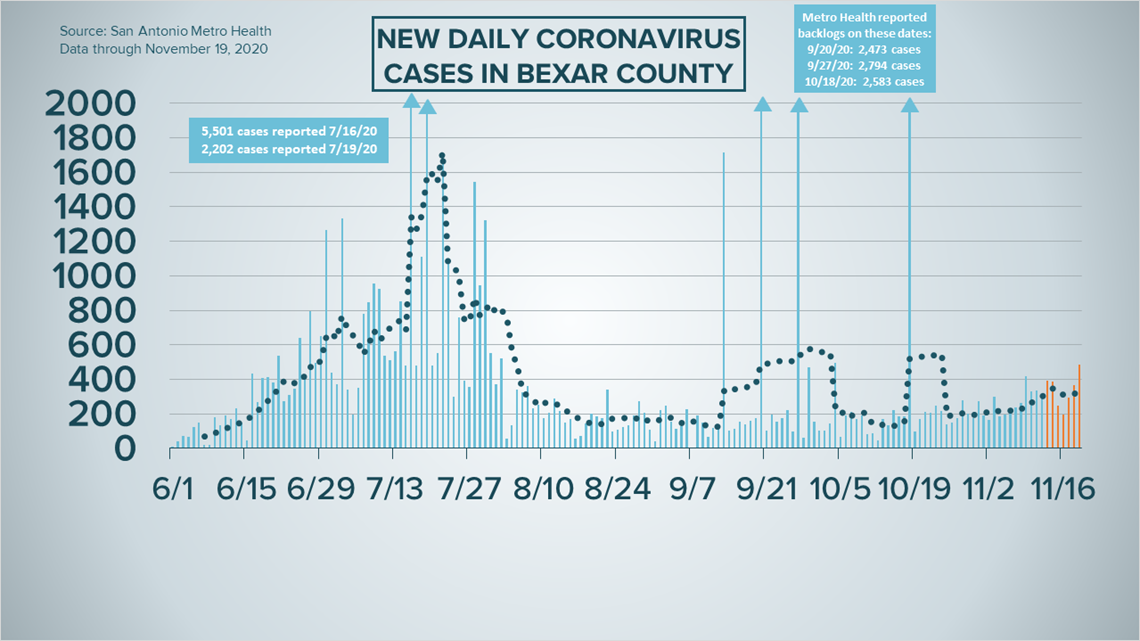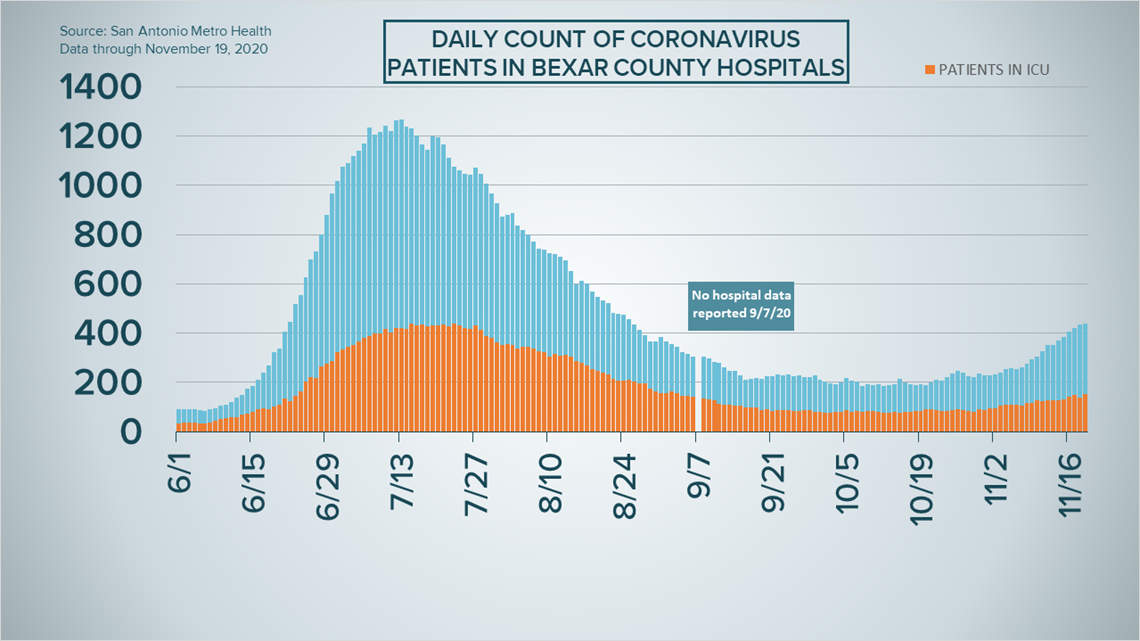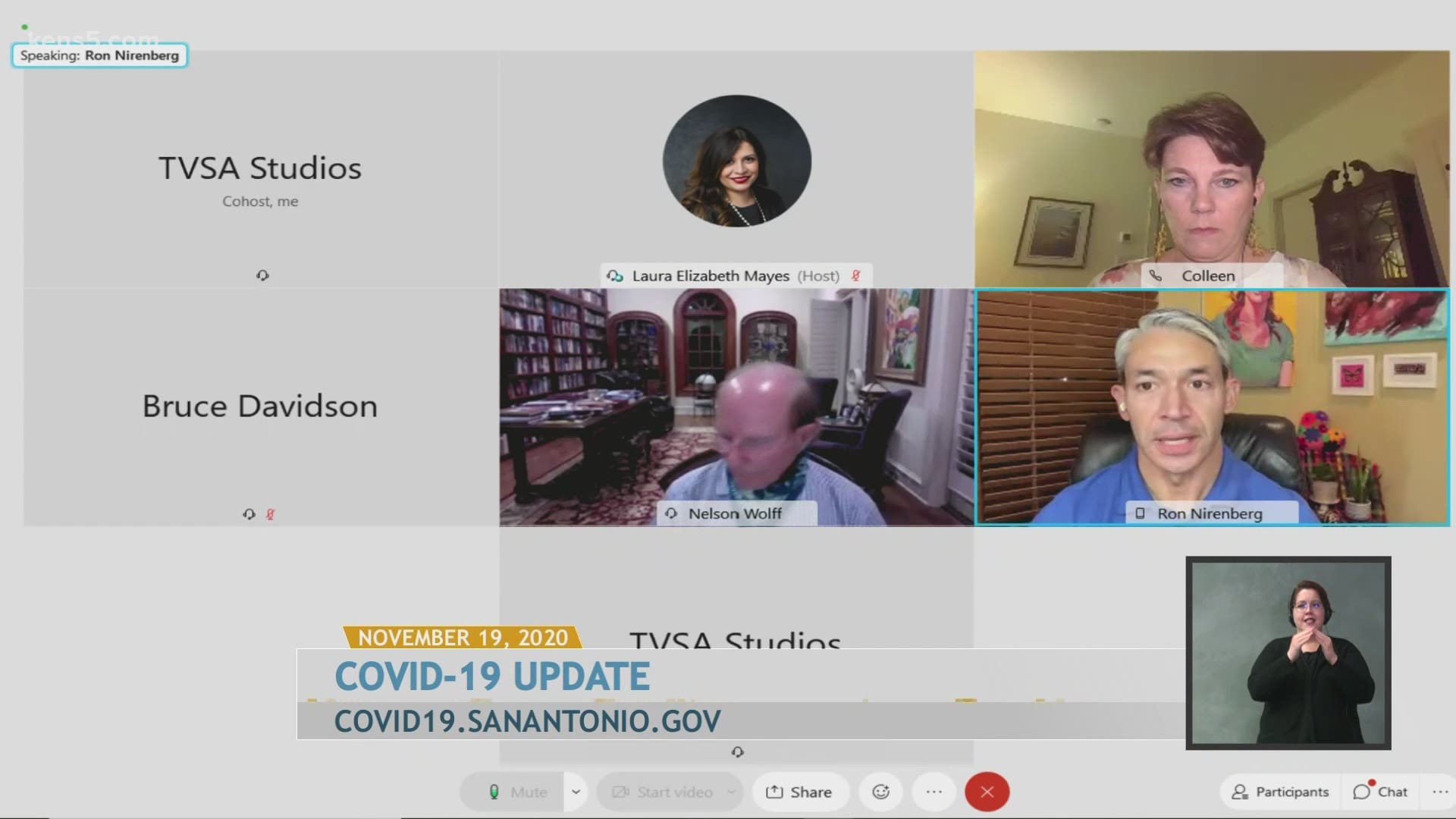SAN ANTONIO — We're tracking the latest numbers from the coronavirus pandemic in San Antonio and across Texas. Here are the latest numbers reported by Bexar and surrounding counties:
- Bexar County: 483 new cases were reported Thursday, bringing the total number of cases for the county to 71,377. Two new deaths were also reported, bringing the death toll to 1,309.
- Comal County: The county reported 50 new COVID-19 cases Friday and no new virus-related deaths. There have been a total of 4,338 reported cases of COVID-19 in the county – including 3,110 lab-confirmed cases – while 125 county residents have died. County officials say there are 398 active coronavirus cases, and 3,815 residents are considered recovered.
- Hays County: Officials in Hays County on Thursday reported 66 new cases in the county and two additional COVID-related fatalities. As of Thursday, there are a total of 6,899 lab-confirmed cases in the county (648 of which are active), while the death toll rose to 95. 6,156 residents have recovered from the virus.
More county case information is available through the Texas Department of Health Services COVID-19 dashboard.
How Bexar County is trending
We've tracked how many coronavirus cases have been confirmed in Bexar County from the time officials began reporting cases in March 2020. The graphic below shows the number of cases since June and charts those daily case numbers along a 7-day moving average to provide a more accurate picture of the overall coronavirus case curve in our area and the direction we're trending amid the pandemic.
San Antonio Mayor Ron Nirenberg reported an additional 483 novel coronavirus cases in Bexar County, bringing the local total to 71,377 since the pandemic began. The high single-day total caused the seven-day diagnosis average to jump from 295 to 321.
Thursday marks the first instance of at least 400 new daily diagnoses since Nov. 9 (417) and the fourth overall since the end of July.
Nirenberg also reported an additional pair of COVID-19-related deaths, raising the death toll to 1,309.


The number of hospitalizations in Bexar County increased by a few patients on Thursday, rising by five to 440; 61 of those are patients from the El Paso area. The number of hospitalized COVID-19 patients on ventilators (65) went down, while the number of those in intensive care (153) rose.


Coronavirus in Texas
The total number of novel coronavirus cases in the state since the pandemic began grew by 13,612 on Thursday, according to the Texas Department of State Health Services, including 12,293 new cases. The rest are cases attributed to backlogs that were previously not included in the state's total. (More details can be found at the top of this page.)
The state's seven-day moving average for newly reported cases is now 9,493 The peak seven-day average during the summer's COVID-19 surge was 9,564 new cases per day, on July 20.
As of Wednesday, 1.105 million Texans have contracted COVID-19.


State health authorities also reported 230 additional virus-related deaths on Thursday, the most in one day since August. The state has reported at least 20,113 Texans have passed away from COVID-19 complications.
On Thursday, the overall number of Texans hospitalized for COVID-19 saw a marginal increase of 24, bringing the current total to 7,982. Last week, that number passed 7,000 for the first time since early August.
Since the beginning of November, the number of Texas hospitalizations have gone up by nearly 40%, continuing a trend that began in early October that indicates a resurgent virus spread in the Lone Star State.
The state estimates that 896,191 Texans have recovered, while 147,030 Texans remain ill with COVID-19.
Meanwhile, the latest update from the Texas Education Agency showed that there have been 50,420 cumulative cases among staff and students across the state through Nov. 15. More information can be found here.
The TEA releases new data on school cases every Thursday.
Latest Coronavirus Headlines
- COVID-19 vaccine could be 'a major contribution to global health'
- Southwest ISD and Curative offer free COVID-19 saliva testing for community members
- Fauci: Pfizer, Moderna coronavirus vaccine efficacy on level of measles vaccine
- 'We're certainly at risk of seeing a major surge,' SA epidemiologist weighs in on city's future
- President-elect Biden tells governors he'll help states overcome coronavirus
- UT researchers say COVID-19 projections show 'troubling signs of increases' heading into the holidays
- CDC recommends Americans don't travel for Thanksgiving amid rise in COVID-19 cases
- Empty desks: Coronavirus robs US classrooms of teachers
- Coronavirus immunity could last years, study reveals
- Coalition seizes on COVID-19 pandemic to boost 'Obamacare' sign-ups
Coronavirus symptoms
The symptoms of coronavirus can be similar to the flu or a bad cold. Symptoms include fever or chills, cough, shortness of breath or difficulty breathing, fatigue, muscle or body aches, headache, new loss of taste or smell sore throat, congestion or runny nose, nausea or vomiting and diarrhea, according to the Centers for Disease Control.
Most healthy people will have mild symptoms. A study of more than 72,000 patients by the Centers for Disease Control in China showed 80 percent of the cases there were mild.
But infections can cause pneumonia, severe acute respiratory syndrome, kidney failure, and even death, according to the World Health Organization. Older people with underlying health conditions are most at risk.
But infections can cause pneumonia, severe acute respiratory syndrome, kidney failure, and even death, according to the World Health Organization. Older people with underlying health conditions are most at risk.
Experts determined there was consistent evidence these conditions increase a person's risk, regardless of age:
- Chronic kidney disease
- COPD (chronic obstructive pulmonary disease)
- Obesity (BMI of 30 or higher)
- Immunocompromised state (weakened immune system) from solid organ transplant
- Serious heart conditions, such as heart failure, coronary artery disease, or cardiomyopathies
- Sickle cell disease
- Type 2 diabetes
The CDC believes symptoms may appear anywhere from two to 14 days after being exposed.
Human coronaviruses are usually spread...
- Between people who are in close contact with one another (within about 6 feet).
- Through respiratory droplets produced when an infected person coughs, sneezes or talks. These droplets can land in the mouths or noses of people who are nearby or possibly be inhaled into the lungs.
- Some recent studies have suggested that COVID-19 may be spread by people who are not showing symptoms.
Help stop the spread of coronavirus
- Stay home when you are sick.
- Eat and sleep separately from your family members
- Use different utensils and dishes
- Cover your cough or sneeze with your arm, not your hand.
- If you use a tissue, throw it in the trash
Find a Testing Location
City officials recommend getting a COVID-19 test if you experience fever or chills, cough, shortness of breath or difficulty breathing, fatigue, muscle or body aches, headache, new loss of taste or smell, sore throat, congestion or runny nose, nausea or vomiting, or diarrhea.
San Antonio operates several no-cost testing locations, including two walk-up locations open Monday-Sunday from 10 a.m. until 2 p.m.:
Cuellar Community Center
5626 San Fernando St.
San Antonio, TX 78237
Ramirez Community Center
1011 Gillette Blvd.
San Antonio, TX 78224
Additionally, Freeman Coliseum offers drive-through no-cost testing from Monday through Sunday between 9 a.m. and 4 p.m. An appointment is required and can be made either online or by calling (833) 213-0643.
Here's a Testing Sites Locator to help you find the testing location closest to you in San Antonio.

